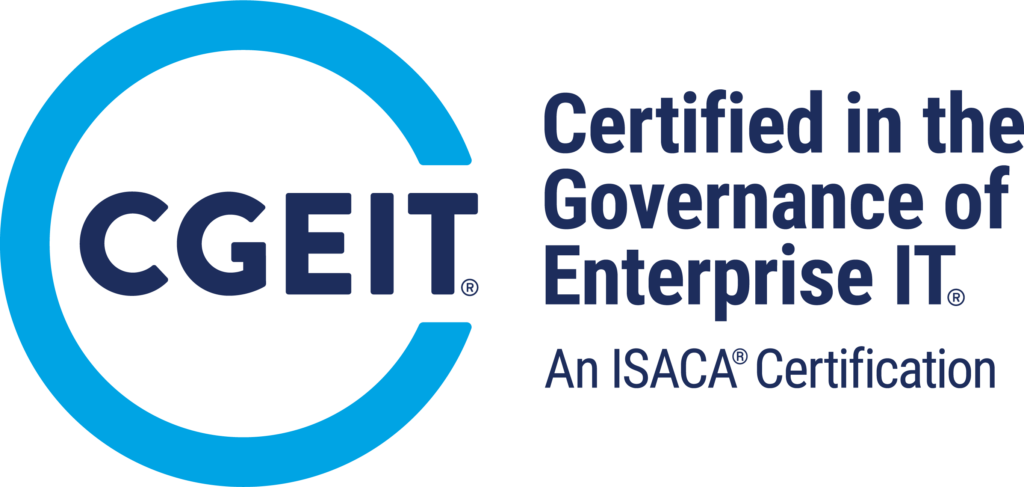In today’s rapidly evolving digital landscape, organizations face unprecedented challenges in managing governance, risk, and compliance (GRC) processes effectively. The Certified in the Governance of Enterprise IT (CGEIT) certification, offered by ISACA, serves as a benchmark for professionals seeking to demonstrate their expertise in IT governance and enterprise risk management.
What is CGEIT Certification?
CGEIT certification signifies a professional’s ability to align IT governance practices with overall enterprise objectives, ensuring that IT investments deliver value while managing risks appropriately. Recognized globally, CGEIT certification validates an individual’s knowledge and skills in governance frameworks, risk management, and compliance regulations related to IT governance.

Why Pursue CGEIT Certification?
1. Career Advancement Opportunities – CGEIT opens doors to senior-level positions, such as IT governance managers, chief information officers (CIOs), and chief risk officers (CROs), enabling career progression and increased earning potential.
2. Demonstrated Expertise in IT Governance – CGEIT certification demonstrates proficiency in implementing and managing IT governance frameworks, ensuring alignment between IT strategies and business objectives.
3. Enhanced Organizational Value – CGEIT-certified professionals contribute to the enhancement of organizational value by effectively managing IT-related risks, ensuring regulatory compliance, and optimizing IT investments.
What Topics Does CGEIT Cover?
1. IT Governance Frameworks – Understanding different IT governance frameworks, such as COBIT (Control Objectives for Information and Related Technologies), and their application in organizational settings.
2. Risk Management – Identifying, assessing, and mitigating IT-related risks to ensure the confidentiality, integrity, and availability of organizational assets.
3. Compliance Regulations – Navigating regulatory requirements and compliance standards relevant to IT governance, such as GDPR (General Data Protection Regulation) and PCI DSS (Payment Card Industry Data Security Standard).
4. Strategic Alignment – Aligning IT strategies with business objectives to enhance organizational performance and drive value creation.
5. Resource Optimization – Optimizing IT resources and investments to maximize returns while minimizing risks and enhancing operational efficiency.
6. Performance Measurement – Establishing key performance indicators (KPIs) and metrics to evaluate the effectiveness of IT governance practices and drive continuous improvement.
Who Should Pursue CGEIT Certification?
1. IT Governance Professionals – Professionals responsible for designing, implementing, and managing IT governance frameworks within organizations.
2. Risk Management Specialists – Individuals involved in assessing and mitigating IT-related risks to protect organizational assets and ensure business continuity.
3. Compliance Officers – Compliance professionals tasked with ensuring adherence to regulatory requirements and industry standards in IT governance practices.
4. Senior IT Leaders – Executives and senior managers seeking to enhance their understanding of IT governance principles and their application in strategic decision-making processes.
How to Prepare for the CGEIT Exam
1. CGEIT Exam Study Materials – Utilize ISACA’s official study materials, including review manuals, practice questions, and exam prep guides, to familiarize yourself with the exam content and format.
2. Training Courses and Workshops – Enroll in training courses offered by accredited training providers, such as Global Knowledge and IT Governance, to gain in-depth knowledge and practical insights into IT governance principles and practices.
3. Self-Study and Practice Tests – Supplement your learning with self-study resources, such as online tutorials, articles, and practice tests, to reinforce key concepts and assess your readiness for the exam.
4. Peer Learning and Networking – Engage with fellow CGEIT aspirants through online forums, study groups, and networking events to exchange ideas, share experiences, and gain valuable insights into the CGEIT certification journey.
Conclusion
In summary, CGEIT certification is a testament to an individual’s expertise in IT governance, risk management, and compliance, essential components for driving organizational success in today’s digital age. By obtaining CGEIT certification, professionals can unlock new career opportunities, contribute to organizational value creation, and play a pivotal role in navigating the complex IT governance landscape with confidence and proficiency.